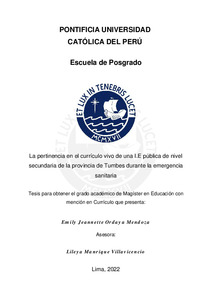| dc.contributor.advisor | Manrique Villavicencio, Lileya | |
| dc.contributor.author | Ordaya Mendoza, Emily Jeannette | |
| dc.date.accessioned | 2022-10-09T13:17:32Z | |
| dc.date.available | 2022-10-09T13:17:32Z | |
| dc.date.created | 2022 | |
| dc.date.issued | 2022-10-09 | |
| dc.identifier.uri | http://hdl.handle.net/20.500.12404/23497 | |
| dc.description.abstract | Esta investigación aborda el tema de la concreción de la pertinencia en el currículo
vivo por lo que en este trabajo se busca responder a la pregunta, ¿Cómo se
comprende y concretiza la pertinencia en el currículo vivo durante la emergencia
sanitaria en una I.E. pública de nivel secundaria de la provincia de Tumbes?
El objetivo general es indagar cómo se comprende y concretiza la pertinencia en el
currículo vivo durante la emergencia sanitaria en una I.E pública de nivel secundaria
de la provincia de Tumbes, y los objetivos específicos son: a) Identificar el
significado de la pertinencia curricular y b) Describir cómo se concretiza la
pertinencia a nivel aula.
El enfoque de investigación es cualitativo, de nivel descriptivo. El método utilizado es
el estudio de casos, de tipo único y para recoger la información se aplicó el guión de
entrevista semiestructurada a docentes y directivos informantes. Además, para el
tratamiento y análisis de los datos se utilizó la codificación abierta y la triangulación
de fuentes.
Finalmente, algunos de los resultados más relevantes son que para los informantes,
la pertinencia curricular tiene relación con los conceptos de contextualización y
adecuación curricular, lo que conllevó a que se realizarán acciones en la práctica
desde el proceso de diseño de las experiencias de aprendizaje como la modificación
de las situaciones significativas y los contenidos de aprendizaje, y desde el proceso
de implementación de las clases a distancia, se efectuaron cambios significativos en
la secuencia didáctica según los requerimientos que surgían en el momento
sincrónico de la clase. Estas acciones acercaron a los alumnos a la realidad en la
que están insertos, sin dejar de lado las características y necesidades del grupo
humano que atiende la I.E. | es_ES |
| dc.description.abstract | This research addresses the issue of the relevance in the living curriculum, so this
work seeks to answer the question, How is relevance in the living curriculum
understood and concretized during the health emergency in a public secondary
school in the province of Tumbes?
The general objective is to investigate how relevance is understood and concretized
in the living curriculum during the health emergency in a public secondary level
school in the province of Tumbes, and the specific objectives are: a) Identify the
meaning of curricular relevance and b) Describe how relevance is achieved at the
classroom level.
The research approach is qualitative and the method used is the case study, of a
unique type and to collect the information, the semi-structured interview script was
applied to teachers and managers. In addition, open coding and triangulation of
sources were used for the treatment and analysis of the data.
Finally, some of the most relevant results are that for the informants, the curricular
relevance is related to the concepts of contextualization and curricular adaptation,
which led to actions being carried out in practice from the process of designing
learning experiences as the modification of the significant situations and the learning
contents, and from the process of implementation of the distance classes, significant
changes were made in the didactic sequence according to the requirements that
arose in the synchronous moment of the class. These actions brought the students
closer to the reality in which they are inserted, without neglecting the characteristics
and needs of the human group that attends the I.E. | es_ES |
| dc.language.iso | spa | es_ES |
| dc.publisher | Pontificia Universidad Católica del Perú | es_ES |
| dc.rights | info:eu-repo/semantics/openAccess | es_ES |
| dc.rights.uri | http://creativecommons.org/licenses/by-nc-sa/2.5/pe/ | * |
| dc.subject | Educación secundaria--Currículo | es_ES |
| dc.subject | Educación secundaria--Perú--Tumbes | es_ES |
| dc.subject | Planificación curricular | es_ES |
| dc.subject | COVID-19 (Enfermedad)--Impacto | es_ES |
| dc.title | La pertinencia en el currículo vivo de una I.E pública de nivel secundaria de la provincia de Tumbes durante la emergencia sanitaria | es_ES |
| dc.type | info:eu-repo/semantics/masterThesis | es_ES |
| thesis.degree.name | Maestro en Educación con mención en Currículo | es_ES |
| thesis.degree.level | Maestría | es_ES |
| thesis.degree.grantor | Pontificia Universidad Católica del Perú. Escuela de Posgrado | es_ES |
| thesis.degree.discipline | Educación con mención en Currículo | es_ES |
| renati.advisor.dni | 08697895 | |
| renati.advisor.orcid | https://orcid.org/0000-0002-1044-6298 | es_ES |
| renati.author.dni | 44647422 | |
| renati.discipline | 191327 | es_ES |
| renati.juror | Saldaña Usco, Yannina Yanire | es_ES |
| renati.juror | Manrique Villavicencio, Lileya | es_ES |
| renati.juror | Maldonado Fuentes, Ana Carolina | es_ES |
| renati.level | https://purl.org/pe-repo/renati/level#maestro | es_ES |
| renati.type | https://purl.org/pe-repo/renati/type#tesis | es_ES |
| dc.publisher.country | PE | es_ES |
| dc.subject.ocde | https://purl.org/pe-repo/ocde/ford#5.03.01 | es_ES |






